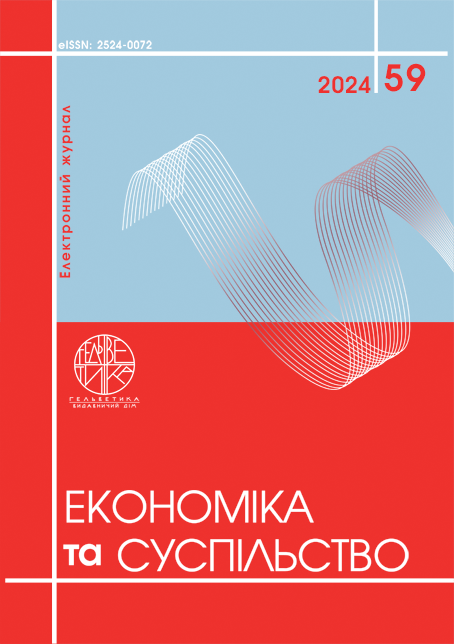FORMATION OF INTERNATIONAL LOGISTICS CHAINS IN THE CONTEXT OF STRATEGIC CHANGES IN THE COMPETITIVE ENVIRONMENT
Abstract
The purpose of this study is to analyze the global logistics supply chain in the context of strategic changes in the competitive environment. The methodology is to identify global supply and distribution logistics chains, improve customer service and increase added value, optimize warehouse inventory, reduce total deliveries, optimize inventory management, reduce total delivery costs and lead times, achieve lower breakeven costs, and improve operational flexibility, customization, and partner relationships to improve competitive market positions using various scientific methods. Advances in information technology, the emergence of new products with shorter life cycles, increased competition in global markets, and higher customer expectations have contributed to the development of new approaches to supply chain management. In recent years, supply chain management has seen a shift in emphasis toward a more integrated approach to procurement, manufacturing, and distribution of products and services to customers. The challenge of integrating and redesigning an efficient and effective supply chain lies in the complexity of adopting a strategy that will help businesses improve performance across many different dimensions: reducing costs, improving service levels, optimizing resource utilization, and responding effectively to market changes. This study proposes various strategies in the areas of procurement, production/operations, marketing and distribution that can provide a competitive global supply chain strategy to increase the value of the company's products/services for the end user.The study identifies the features of the formation of an integrated logistics system as a key tool that allows, based on the collected data, to simplify the process of making management decisions and provide optimization and support at various stages, which requires identifying strategies to reduce costs and create added value in a changing competitive environment.
References
Крикавський, Є. В. Логістика та управління ланцюгами поставок: підручник. Львів : Вид-во Львів. політехніки. 2020. 848 с.
Чубенко А. Г., Лошицький М. В., Павлов Д. М., Бичкова С. С. Ланцюг поставок. Юнін. Київ: Ваіте. 2018. 381 с.
Аль-Машарі, М. та М. Заїрі, Реінжиніринг ланцюгів поставок з використанням систем планування ресурсів підприємства (ERP): Аналіз прикладу впровадження SAP R/3. Міжнародний журнал фізичної дистрибуції та логістики. №30(3-4), 2000. С. 296-313.
Лі, Х. і Д. Амарал. Постійне і стійке вдосконалення через управління ефективністю ланцюгів поставок. Стенфордський форум з управління глобальними ланцюгами поставок SGSCMF-W1, жовтень 2002.
Редді, Р. і С. Редді. Ланцюги поставок до віртуальної інтеграції, McGraw-Hill. 2001.
Сімчі-Леві, Д., П. Камінський та Е. Сімчі-Леві, (2003). Проектування та управління ланцюгами поставок. Друге видання, McGraw-Hill.
Форрестер, Дж. В. Промислова динаміка, MIT Press, Кембридж, Массачусетс. 1961.
Форрестер, Дж. В., Промислова динаміка: Великий прорив для тих, хто приймає рішення. 1958, Harvard Business Review 36(4), с. 37-66.
Хойт, Д. Lucent Technologies: Глобальне управління ланцюгами поставок. Вища школа бізнесу. Стенфордський університет, 2000. GS-01, січень.
Набока Р. М., Шукліна В. В. Вплив інтеграції логістичних ланцюгів поставок на підвищення потенціалу підприємства. Ефективна економіка. 2020. № 4. DOI: https://doi.org/10.32702/2307-2105- 2020.4.87
Петруня Ю. Є., Пасічник Т. О. Вплив новітніх технологій на логістику та управління ланцюгами поставок. Маркетинг і менеджмент інновацій. 2018. № 1. С. 130-139. DOI: http://doi.org/10.21272/mmi.2018.1- 09.
Krykavskyi, Ye. V. (2020). Lohistyka ta upravlinnia lantsiuhamy postavok: pidruchnyk [Logistics and supply chain management: a textbook]. Lviv : Vyd-vo Lviv. Politekhniky. 2020. 848 s.
Chubenko A. H., Loshytskyi M. V., Pavlov D. M., Bychkova S. S. Yunin O. S. (2018). Lantsiuh postavok [Supply chain]. Kyiv: Vaite. 2018. 381 s.
Al-Mashari, M., M. Zairi. (2000). Reinzhynirynh lantsiuhiv postavok z vykorystanniam system planuvannia resursiv pidpryiemstva (ERP): Analiz prykladu vprovadzhennia SAP R/3 [Reengineering Supply Chains using Enterprise Resource Planning (ERP) Systems: Analyzing an SAP Implementation Example R/3]. Mizhnarodnyi zhurnal fizychnoi dystrybutsii ta lohistyky. 30(3-4). S. 296-313.
Li, Kh. i D. Amaral. (2002). Postiine i stiike vdoskonalennia cherez upravlinnia efektyvnistiu lantsiuhiv postavok [Continuous and sustained improvement through supply chain performance management]. Stenfordskyi forum z upravlinnia hlobalnymy lantsiuhamy postavok SGSCMF-W1.
Reddi, R. i S. Reddi (2001). Lantsiuhy postavok do virtualnoi intehratsii. [Supply Chains to Virtual Integration]. McGraw-Hill.
Simchi-Levi, D., P. Kaminskyi ta E. Simchi-Levi. (2003). Proektuvannia ta upravlinnia lantsiuhamy postavok [Supply Chain Design and Management. Druhe vydannia]. McGraw-Hill.
Forrester, Dzh. V. (1961). Promyslova dynamika [Industrial Dynamics]. MIT Press, Kembrydzh, Massachusets.
Forrester, Dzh. V. (1958). Promyslova dynamika: Velykyi proryv dlia tykh, khto pryimaie rishennia [Industrial dynamics: A big breakthrough for decision makers]. Harvard Business Review 36(4): s. 37-66.
Khoit, D. (2000). Lucent Technologies: Hlobalne upravlinnia lantsiuhamy postavok [Global Supply Chain Management Vyshcha shkola biznesu]. Stenfordskyi universytet. GS-01.
Naboka R. M., Shuklina V. V. (2020). Vplyv intehratsii lohistychnykh lantsiuhiv postavok na pidvyshchennia potentsialu pidpryiemstva [Impact of supply chain integration on enterprise capacity]. Efektyvna ekonomika. № 4. DOI: https://doi.org/10.32702/2307-2105- 2020.4.87
Petrunia Yu. Ye., Pasichnyk T. O. (2018). Vplyv novitnikh tekhnolohii na lohistyku ta upravlinnia lantsiuhamy postavok [Impact of new technologies on logistics and supply chain management]. Marketynh i menedzhment innovatsii. № 1. S. 130-139. DOI: http://doi.org/10.21272/mmi.2018.1- 09.

This work is licensed under a Creative Commons Attribution 4.0 International License.


